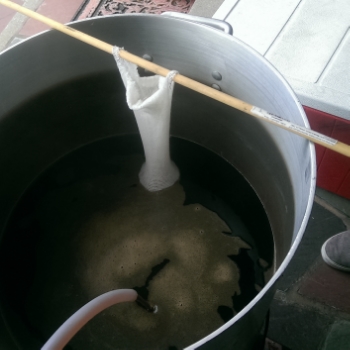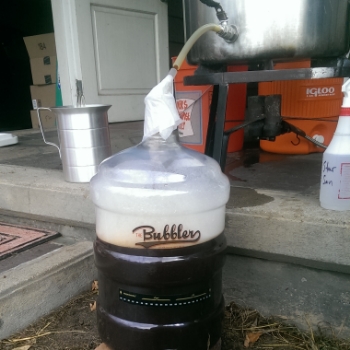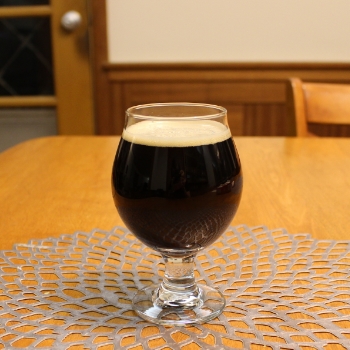Barrel Aged English Dark Mild
Waiting is hard, but it's worth it.
I knew when I got my barrel I was going to put a few clean beers in it before switching it over to funky/sour beers. The first beer to go through the barrel, a Russian Imperial Stout, turned out fantastic, but was also an obvious choice for a whiskey barrel. For beer number two, I wanted to go a bit off the books and do something small. A beer that would be complimented by the lingering bits of whiskey flavor left in the barrel and could do with a bit of a body punch up by the oak. Something that you don't regularly see on the shelves of your favorite liquor store. The more I thought about it, the more it became obvious, I was going to to an English Dark Mild and age it just until the oak started to peek through.
Milds, as you could guess by their name, are mild beers by nature. They don't have huge flavor profiles and don't get you drunk just by smelling them. They're low in ABV and while they can pack a good punch flavor-wise, they're beers meant to be drunk in large amounts, so there's nothing too aggressive about them. There are lighter and darker milds, and can run the flavor gamut from sweet and caramelly to dry and roasty with chocolate, dark fruit, coffee, or licorice notes sprinkled in. Dark milds are often akin to a light porter, with a bit of roast and toast to their malt profile, with some chocolate/coffee underpinnings, and I thought this would be a great beer to put through my barrel after the stout.
I crushed it with this grain bill.
English Dark Mild recipe, batch size 12 gallons (increased to 12 gallons as the barrel is a bit larger than 10 gallons and I wanted to fill it up more):
Grains
- 14 lbs Maris Otter
- 1 lb 4 oz Crystal Malt 120L
- 12 oz Crystal Malt 40L
- 8 oz Pale Chocolate Malt (350 SRM)
- 6 oz Black Malt (500 SRM)
Mash at 154F for 1 hour, add boiling water to raise temp to 170F, then drain and batch sparge, boil for 60 min
Boil additions:
- 1 oz East Kent Goldings @ First Wort Hopping
- 1 oz East Kent Goldings @ 30 minutes
- rish Moss @15 minutes
- 1 oz each East Kent Goldings and Fuggles @ 10 minutes
Fermentation Plan:
- Grew up 1L starter of WLP013 London Ale Yeast, and used 500ml for each carboy
- Ferment at 65F for 7 days, then brought up to 70F and hold at 70F for 1 week
- Bring carboys to basement (65F-70F), let settle, then rack to barrel
- Add 100g of sugar (boiled and cooled in 1 cup of water) to barrel to trigger small amount of fermentation to help purge oxygen from both the beer and barrel to help prevent oxidation.
On brew day, I filled up my boil kettle with water straight from my tap, added 7.6g of CaCl2, and heated up the water so I could mash in. After mashing, I added boiling water to heat the mash up to 170 so I could kill enzymatic activity and started collecting my first runnings.
Fill 'er up!
I ended up with really, really good efficiency (which is to be expected when you're shooting for a beer around 1.038 final gravity. So I ended up collecting almost 3 extra gallons of wort that I boiled down on my stove top to 1 gallon with a small amount of tettnanger hops that I added a bit of my WLP013 starter to and some bottle dregs of a Modern Times sour to, just to see what would happen. The OG on this experiment was around 1.055, with IBUs around 15.
For the boil, I usually collect around 12 gallons and boil down to ~10.5, but since I wanted 12 gallons at the end of the brew, I ended up with an almost full pot, which made preventing boil-overs fun for the first 15 minutes.
Hey Bubbler, want to give me some ad money?
After the boil, the wort was cooled rather quickly, added to my carboys, and then chilled down to 65F. I added the yeast and fermented as planned and brought the carboys to the basement after 2 weeks to settle a bit more before racking to the barrel when it was available.
I ended up bottling and kegging the stout on Halloween, and the mild was ready too, so after draining the barrel of the stout, I immediately added back the dark mild. Initial impressions were good, some earthy/tobacco notes from the fuggles hops and yeast, and a nice malt presence with a hint of chocolate roast coming through.
It only looks really scary down here.
After 3 weeks in the barrel, about the same amount of time as the stout stayed in, I stole a sample and was very, very excited. The body of the beer definitely bulked up a bit, there was just a subtle touch of oak on the back-end, and the whiskey notes were poking their little head into the fray too. I left it go another week just to pump up those notes by a touch and then kegged it. The final version is such a treat, real easy to drink, the subdued whiskey notes play so well with the malts from the beer, there are hints of coconut and a lingering sweetness that really works well. For a small beer, the body isn't watery or overly thin. I'm already getting sad and missing the beer when I drink the last of it.
It's an absolute thing of beauty.
Final numbers for my Barrel Aged English Dark Mild:
- Batch Size: 12 gallons
- Original Gravity: 1.038
- Final Gravity: 1.009
- ABV: 3.8%
- IBU: 21





